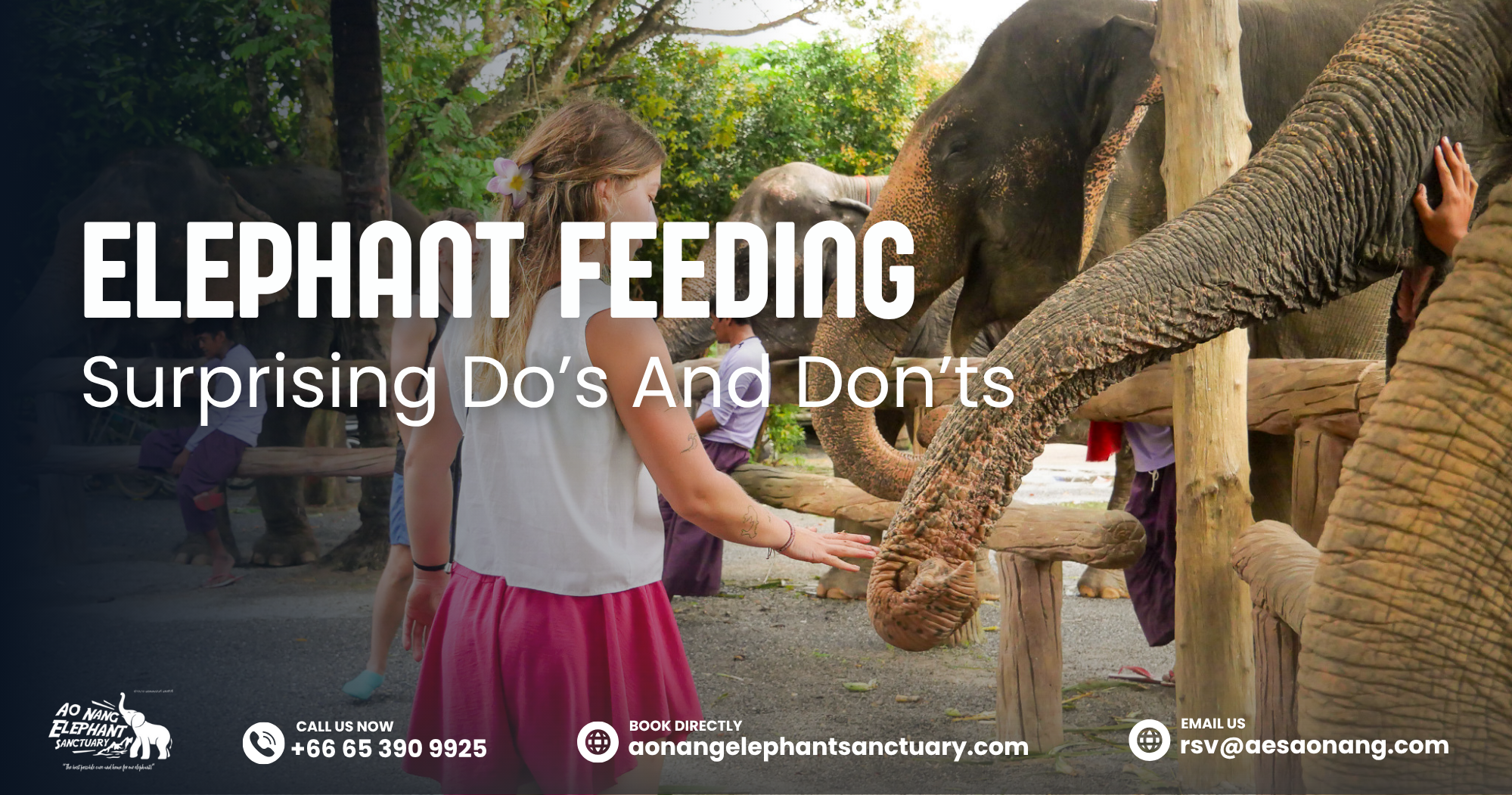Just the thought of visiting Thailand could lead you to envision elephant feeding and a majestic elephant walking silently through the jungle. In Krabi, this dream turns into a journey beyond imagination at Ao Nang Elephant Sanctuary. The most intimate and moving part of this adventure is feeding the elephants.
This blog post will delve into the details of how to go about an elephant feeding activity in the sanctuary. What to pack, what to stay away from, and reasons for this event being more than simply taking photos.
Understanding Elephant Feeding At Ethical Sanctuaries
As they are in places like Ao Nang Elephant Sanctuary, elephants don’t have industries for logging or entertainment anymore. They have been saved and given a new, and more natural life. Feeding will be a very important task in their daily activities and wellness, as well as keeping their human trust…
Feeding in commercial centers may feel as if it were a deal, however, elephant feeding sessions of Ao Nang Elephant Sanctuary are organized in such a way that the animals’ behaviors emerge as the main priority. From time to time, the food is cooked in such a way that it is similar to their wild diet, and guests are instructed on how to offer it politely.
What Makes Ethical Elephant Feeding Different
Ao Nang Elephant Sanctuary’s main emphasis is on elephants’ happiness and not their work. Elephant feeding is a key part of a whole-circle care system that also comprises health examinations, physical activity by walking, and socializing with other elephants.
The workers at the sanctuary make use of only such foods for the elephants, which can help the elephants digest and are good for their teeth.
The visitors get involved in the process of making the supplementary foods-organic balls consisting of rice, bananas, salt, and tamarind. This elephant feeding activity that involves a person’s hands is like a window that shows the dietary needs of the elephants, and it also becomes a kind of care and connection that is deeply felt.
In serving the treats, you are not the only one that is being taken care of; it is the larger wellness routine that comes to their aid and is responsible for their recovery and happiness.
Elephant Nutrition 101: What They Love & What To Avoid
Elephant’s Favorite Food
In the wild, elephants nibble food for up to 16 hours. Their diet at the sanctuary is planned in such a way that it corresponds with their natural diet. Some examples of foods that could be included in the list of things that the elephants can be fed with are:
- Bananas: A favorite treat, especially when overripe—elephant eating a banana is a common sight during feeding sessions, as they enjoy the soft texture and sweetness.
- Sugarcane: Crunchy and sweet, perfect for chewing.
- Pineapple: Served with or without the skin.
- Corn: Both fresh corn and corn stalks are nutritious.
- Watermelon: Hydrating and delicious, especially in hot weather.
- Supplementary Food Balls: Mixed by visitors under staff supervision for added nutrition.
Such foods are not only rewards, but they are also the means of health tracking. An elephant’s chewing, swallowing, or responding to certain textures becomes an indication of its dental and digestive condition to the caretakers.
What Not To Feed Elephants
Though it might seem tempting to share your snacks with these giant creatures, it’s critical to follow the sanctuary’s guidelines strictly. Here’s what you should avoid:
- Human Snacks: Anything with salt, sugar, or preservatives is harmful.
- Processed Foods: Cookies, chips, and bread are dangerous for their digestion.
- Plastic-Wrapped Items: Accidental ingestion can be fatal.
- Too Many Treats: Even natural foods can be excessive if not part of their balanced routine.
Respecting The Elephants During Feeding
The experience isn’t only about seeing the elephants eating—it is rather about noting their body language, habits, and wants. The examples are that one of the elephants may simply prefer to take food with the trunk, while the other may use the mouth directly. You will even realize how to spot the states of comfort or discomfort.
Here’s how to interact respectfully during feeding:
- Let the Elephant Set the Pace: Don’t rush or force food into their trunks.
- No Loud Noises or Sudden Movements: Elephants are sensitive and may feel threatened.
- Follow the Caretaker’s Instructions: Every elephant has a different personality and past.
- Don’t Touch the Elephant Unless Invited: Feeding is already a form of contact; avoid overstepping.
Why Elephant Feeding Matters In Conservation
When a person does the feeding and understands the reason why, then he becomes a part of a larger mission: elephant conservation. Each feeding session is a good way for elephant keepers to check the animals’ health, get familiar with humans. It also supports responsible tourism by providing income for those caring for the elephants.
As the animals are no longer being used as a source of entertainment, the funds are used to provide help to veterinarians, correct nutrition, and enrichment. Elephant feeding plays a vital role in this enrichment, helping rescued elephants to transit from their past lives in labor or tourism industries to a more peaceful and self-directed existence.
Not only do the guests have pictures to take home, but they are also new disciples. They know what elephants need the most to grow up and keep this in mind when making decisions in the future. Visitors are, thus, not likely to contribute to unethical tourism practices such as riding or circus shows after they have witnessed how tender and smart these animals are.
Packing Tips For Your Visit To Ao Nang Elephant Sanctuary
Before arriving at the sanctuary, here are a few things you should bring for the elephant feeding session:
- Comfortable Clothing: Expect to get messy. Feeding often involves handling fruits and preparing food balls with your hands.
- Flip-Flops or Water Shoes: Since feeding can be followed by mud or water activities, easy-to-clean footwear is ideal.
- Towel and Change of Clothes: After feeding, you might participate in bathing or walking with the elephants.
- Camera or Smartphone: You’ll want to capture the moment, but make sure it doesn’t interfere with the experience.
- Sunscreen and Bug Spray: You’ll be outdoors most of the time, and protection is essential.
Most importantly, you should have an open mind and be courteous. It must be done ethically for feeding an elephant to become an emotionally powerful experience; it is about the bond, not the fun.
Why Elephant Feeding At Ao Nang Is More Than Just A Treat
Feeding an elephant was a simple act that seemed only, but at Ao Nang Elephant Sanctuary, it turns into a deeply meaningful, educational, and life-changing event. The reason is that you are not only giving them fruit but also learning ethical care and becoming part of a global responsible tourism movement.
If your plan is to go to Krabi and want to establish a deep relationship with Thailand’s nature, you must not miss the opportunity to visit Ao Nang Elephant Sanctuary.
Reserve your spot now to get a chance to meet Asian elephants!
- Phone: +66 65 390 9925
- Email: [email protected]
- Book directly at aonangelephantsanctuary.com




